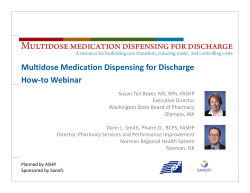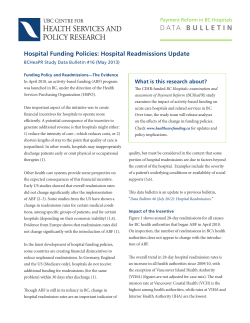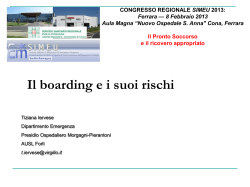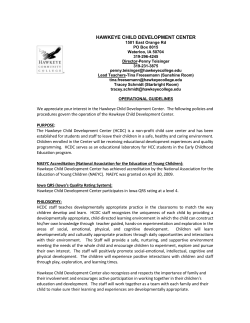
An Update on CMS Quality Programs:
An Update on CMS Quality Programs: Pharmacists can shine in new era of patient outcomes and efficiency! Steven M. Riddle, PharmD, BCPS, FASHP Vice President of Clinical Affairs Pharmacy OneSource/ Wolters Kluwer Health Clinical Assistant Professor, UW School of Pharmacy January 15, 2014 Disclosure • I am an paid employee of Wolters Kluwer Health • I will not be speaking about any of the company‟s products or services 2 Learning Objectives • Improve understanding of the new elements emerging from the CMS Value-based Purchasing Plan that focus on outcomes and cost efficiencies • Review how programs such as the MSSP are structured with regard to quality and cost goals. • Demonstrate the cross-linking and increasing harmonization of quality programs and measures across government programs. • Identify opportunities for pharmacy/pharmacists to take leadership roles around these programs. What’s Happening In Healthcare? Focus on Outcomes and Performance • ↑ Quality and Safety • ↓ Costs (improved efficiencies) Focus on the Continuum of Care • Hospital ↔ Home ↔ Physician Office ↔ LTC Need for Highly Coordinated Care • Cross-disciplinary teams • Integrated care models • Accountability at the all levels 4 HHS* National Healthcare Quality Strategy Making Care Safer Ensuring Person- and Family-Centered Care Promoting Effective Communication & Coordination of Care Promoting the Most Effective Prevention & Treatment of the Leading Causes of Mortality Making Quality Care More Affordable Working with Communities to Promote Wide Use of Best Practices to Enable Healthy Living *US Dept of Health & Human Services: The United States government's principal agency for protecting the health of all Americans and providing essential human services Impact of HC Reform on Hospitals Reform pressures will accelerate the shift of traditional hospital care to more integrated, coordinated, and outpatient-oriented care delivery systems. Hospitals will likely need to move from department-based operations to integrated and patient-focused models of care. Focus will be on controlling costs and creating new revenue streams. The Intersection of Government Healthcare Programs ACA HR RP VBP ACO IQR CMS Quality Programs 7 PQ RS ARRA HITECH MU Crosswalk of Quality Measures: CMS, VBP, TJC, MU, Etc Measures CMS IQR CMS PQRS Not inclusive for all measures ACA VBP & HRRP ACA MSSP/ACO ARRA HITECH MU PROCESS OF CARE/ CONDITIONS AMI X CAD/IVD X X X HF X X X Pneumonia (Abx, Vaccine) X X X SCIP/Surgical Care X Stroke X VTE X X Diabetes X COPD X X X X X ? (2015) X ? (2015) X PATIENT EXPERIENCE HCAHPS CAHPS X X X X TOC/READMISSIONS Hospital Readmissions Med Rec 8 X X X X X Alignment of Incentives between Payers & Providers 9 Pharmacy Opportunities The new healthcare environment is an open door for demonstrating our value by impacting patient outcomes and the bottom-line 10 Pharmacy Accountability in the New Healthcare Environment Pharmacists need to align departments/activities with organizational goals! 1. Know your hospitals goals, performance gaps and action plan! 2. Reevaluate your practice model (ie, ASHP PPMI) 3. Are you doing things right or doing the right things? Focus on value-add activities! 11 VBP Domain Description PROCESS OF CARE VBP Measures FY14 FY15 FY16* AMI-7a Fibrinolytic therapy received within 30 minutes of hospital arrival X X X AMI-8a Primary PCI received within 90 minutes of hospital arrival X X HF-1 Discharge Instructions X X IMM-2 Influenza Immunization PN-3b Blood cultures performed in the ED prior to initial antibiotic received in hospital X X PN-6 Initial antibiotic selection for CAP in immunocompetent patient X X X SCIP-Inf-1 Prophylactic antibiotic received within one hour prior to surgical incision X X X SCIP-Inf-2 Prophylactic antibiotic selection for surgical patients X X X SCIP-Inf-3 Prophylactic antibiotics discontinued within 24 hours after surgery end time X X X SCIP-Inf-4 Cardiac surgery patients with controlled 6am postoperative serum glucose X X X SCIP-Inf-9 Urinary catheter removed on postoperative day 1 or postoperative day 2 X X SCIP-Card-2 Surgery patients on prior ß-blocker receive ß-blocker during perioperative period X X X SCIP-VTE-1 Surgery patients with recommended venous thromboembolism prophylaxis ordered X SCIP-VTE-2 Patients receiving appropriate VTE prophylaxis 24 hours prior to and after surgery X X X Patient Satisfaction Measures X X X MORT-30-AMI Acute myocardial infarction 30-day mortality rate X X X MORT-30-HF Heart failure 30-day mortality rate X X X MORT-30-PN Pneumonia 30-day mortality rate X X X PSI-90 Complication/patient safety for selected indicators (composite) X X CAUTI Catheter-Associated Urinary Tract Infection CLABSI Central line associated blood stream infection SSI Surgical Site Infection, Colon, Abdominal Hysterectomy X PATIENT EXPERIENCE HCAHPS OUTCOMES X X X X EFFICIENCY 12 MSPB-1 Medicare spending per beneficiary X X VBP Domain Weighting: Focus Shifts to Meaningful Endpoints 20% 30% 25% 25% 30% 40% 30% Efficiency Outcomes Patient Experience Process of Care 70% 30% 25% 45% 20% 13 2013 2014 2015 10% 2016 VBP Measurement Periods: If you‟re waiting to start…you are too late! Improvement Period YEAR DOMAIN PERFORMANCE 2015 Process of Care Jan – Dec 2011 Jan – Dec 2013 2015 Patient Experience Jan – Dec 2011 Jan – Dec 2013 2015 Outcomes Mortality Oct 2010 – June 2011 Oct 2012 – June 2013 AHRQ PSI Oct 2010 – June 2011 Oct 2012 – June 2013 Jan – Dec 2011 Feb – Dec 2013 May – Dec 2011 May – Dec 2013 CLABSI 2015 14 BASELINE Efficiency Impacting Process Measures VBP Meaningful Use CQM 15 Evaluating Process of Care Measures Measure ID Measure Description Current Performance Threshold/ Benchmark Pharm Impact SCIP-Inf-1 Prophylactic Antibiotic Received Within 1 Hour Pre-Surg Incision 0.9735 0.9998 ? SCIP-Inf-2 Prophylactic Antibiotic Selection for Surgical Patients 0.9766 1.0 ? SCIP-Inf-3 Prophylactic Antibiotics DC‟d w/in 24 hr After Surgery End Time 0.9507 0.9968 ? SCIP-Inf-4 Cardiac Surg Pts with Controlled 6AM Post-Op Serum Glucose SCIP-VTE-2 Surgery Patients Who Received Appropriate VTE Prophylaxis Within 24 Hours Prior/Post Surgery SCIP-Card-2 Surgery Patients on a Beta Blocker Prior to Arrival That Received BB During the Perioperative Period 0.89 0.9428 0.9963 1. 2. 3. 4. High 0.9307 0.9985 0.91 0.9399 1.0 Process Example: 16 Gap Find your current performance Evaluate the perceived gap (High, Medium, Low) Evaluate potential for pharmacy to impact gap (High, Medium, Low) Prioritize opportunities and investigate those with highest scores in Gap and Pharm Impact categories. Med ? High High Threshold = 50th percentile score Benchmark = indicates 90th percentile score VTE & Stroke Measures: Moving to VBP? Venous Thromboembolism (VTE) 6 Measures / 6 Rx impact Venous Thromboembolism Prophylaxis Venous Thromboembolism Patients Receiving UHF with Dosages/Platelet Count Monitoring by Protocol or Nomogram Intensive Care Unit Venous Thromboembolism Prophylaxis Venous Thromboembolism Discharge Instructions Venous Thromboembolism Patients with Anticoagulation Overlap Therapy Incidence of Potentially-Preventable Venous Thromboembolism Stroke (STK) 8 Measures / 6 Rx impact Venous Thromboembolism (VTE) Prophylaxis Thrombolytic Therapy Discharged on Antithrombotic Therapy Antithrombotic Therapy By End of Hospital Day 2 Anticoagulation Therapy for Atrial Fibrillation/Flutter Discharged on Statin Medication Impacting Patient Experience VBP (HCAHPS) ACO Performance Measures 18 HCAHPS Questions with Pharmacy Relevance PAIN • How often was your pain well controlled? • How often did the hospital staff do everything they could to help you with your pain? MEDICATIONS • During this hospital stay, were you given any medicine that you had not taken before? • How often did the hospital staff tell you what your medication was for? • How often did the hospital staff describe possible side effects in a way you could understand? • Did you receive information in writing about what symptoms or health problems to look out for? DIRECTIONS • Did you get information in writing about what symptoms or health problems to look out for after you left the hospital? • When I left the hospital, I clearly understood the purpose for taking each of my medications. At least 8 of 32 questions could be impacted by pharmacy! Evaluating Patient Experience Measures Measure Domain Pain management Communication about medicines Current Performance Threshold/ Benchmark Gap Pharm Impact 70 68.75 77.90 Med Med 61 59.28 70.42 Med High Discharge information 81.93 89.09 ? Responsiveness of hospital staff 61.82 77.69 ? Overall Hospital Rating 66.02 82.52 ? Note: Much lower scores…much bigger gaps. May be place where efforts can have the most impact! 20 HCAHPS and Pain Stewardship: Fairview Health Services Pharmacy Pain set as an institutional priority Pain Stewardship Pharmacist role created Process Defined • Daily report for patients on long‐acting opioids, fentanyl & methadone • Current med profile checked for consistency with patient history “Opioid review” note documented by the PS pharmacist Develop plan for transition to oral, weaning of acute pain medications, and continuity of care Success metrics: # physician consults, improved pain score results, ADEs related to opioids 21 Amplatz Hospital HCAHPS/TOC Improvements Created Medication Teaching Pharmacist Position • 1 FTE from Discharge Pharmacy Reviews all discharge medication orders • Compares the home med list, inpatient med list, and discharge med list • Resolves any drug therapy problems Brings medications to the teaching appointment Creates a MedActionPlan® for complex regimens Conducts medication teaching for the patient/family • Focus is on new medications/dose changes • Teaching points: Basic med info; storage requirements; common side effects, food/medications to avoid; action to be taken if dose is missed, when to call MD, how to obtain refills Documents teaching activities and interventions Provides a follow‐up call to the patient/family after discharge 22 Amplatz Medication Teaching Outcomes Process Measures • % of patients taught/offered teaching at discharge • % of patients with discharge medication reconciliation completed by pharmacist • Time spent teaching/preparing for teaching/reconciling meds • Fairview Discharge Pharmacy prescription capture rate Patient Care Measures: • Type/# of interventions made by PharmD during reconciliation • 30-day readmission rates Patient Satisfaction Measures: • NRC Picker survey results – specific med teaching questions • HCAHPS Scores 23 Survey Says! Test Your Services for Improving HCAHPS • Most facilities have private vendors that conduct patient satisfaction surveys. • Content reflects CMS HCAHPS questions, but also includes other hospital-determined inquiries. • Consider petitioning for addition of questions related to new services such as medication management, patient education or awareness of and satisfaction with pharmacy services (clinical) • Provides platform for data with more rapid turnaround times. 24 HCAHPS Pearls • Successful organizations do not wait until patients arrive at their acute care facilities to address satisfaction issues. o Establish a rapport with patients prior to admission o Nurture relationship after discharge. o Establish closer ties with community physicians as a way of building links with patients • Consider a model that is a context-based that looks at the organizational practices that impact the provider-patient interaction. o Goal is to uncover the barriers that impact successful patient interactions. • Avoid a process engineering approach! o These social interactions require social science methodologies o You are not just “checking the box”! 25 Impacting Patient Outcomes & Cost/Efficiences 26 VBP Outcomes Measures (FFY14,15,16) Measure 30-Day Mortality Measure Description AMI Heart Failure Pneumonia CLABSI Hospital Acquired Conditions CA-UTI SSI (Colon, Abd. Hysterectomy) AHRQ Measures: PSI (Patient Safety Indicators) 27 Pharm Impact Composite indicators • Example: Post-Op PE or DVT Pharmacy‟s Impact on Patient Outcomes How do you impact mortality!? 28 Rx Intervention Examples Ensure EBM care Detect errs of omission Improve agent selection Optimize drug therapy Drive dose optimization (renal, PK) Monitor critical values 24/7 Reduce medication harm ADE and pADE detection Target high-risk agents Provide timely care interventions Real-time identification Optimize adherence Med Hx screening, Access, Targeting problem meds Patient education Risk Stratify, Deliver Care, Document Follow-up care Risk Stratify, Deliver Care, Document VBP Efficiency Measures (FFY15) Measure Medicare Spending per Beneficiary Measure Description Total expenditures per “episode of care” for the period beginning three days prior to admission and ending 30-days postdischarge (including readmissions!) Measure targets care coordination during transitions in care! 29 Pharm Impact Improving Cost per „Episode of Care‟ • Optimize medication-related costs • Decreasing redundancy in care (ie, lab test, procedures) • Control variables that impact LOS (ie, pain) and resource use (ie, depression) • Decrease avoidable events!! • ADE, HAI, Readmissions 30 Targeting Infection Complications and Healthcare-Associated Infections • HAI reduction and elimination is high profile • HHS 5 Year Action Plan on HAI (CMS working with CDC) o HAI = SCIP, SSI, CLABSI, CAUTI o MDROs = MRSA, C dif Consider role in Antimicrobial Stewardship! CMS Pay-for-Performance Measures Related to Infection Measure ID VBP HAC Outcomes CA-UTI VBP HAC Outcomes Vascular-associated catheter infection (CLABSI) 30-day Mortality Pneumonia-related deaths at 30-days 30-day Readmissions 32 Measure Description Pneumonia-related readmissions at 30-days PN-3b Blood Cultures Performed in the ED Prior to Initial Antibiotic Received in Hospital PN-6 Initial Antibiotic Selection for CAP in Immunocompetent Patient SCIP-Inf-1 Antibiotic Received Within 1 Hour Pre-Surg Incision SCIP-Inf-2 Antibiotic Selection for Surgical Patients SCIP-Inf-3 Antibiotics DC’d w/in 24 hr After Surgery End Time SCIP-Inf-4 Cardiac Surgery Pts with Controlled 6AM Post-Op Serum Glucose Reducing Adverse Drug Events: Improving outcomes and reducing cost! • ADEs and the Partnership for Patients o Keen focus on reducing ADEs o Aim: harm due to High-Alert Medications by 50% o Excellent tool kit available • Reducing avoidable trips to the hospital o Seeks to reduce readmissions by 20% http://partnershipforpatients.cms.gov/p4p_resources/tspadversedrugevents/tooladversedrugeventsade.html Hospital Engagement Network (PfP) http://www.hret-hen.org/adverse-drugs-events 33 HOSPITAL READMISSIONS REDUCTION PROGRAM 34 CMS Hospital Readmission Reductions Program • Reduces Medicare inpatient payments for hospitals with higher than expected risk-adjusted 30-day readmission rates for certain conditions. • Penalties are capped, but will expand every year for the first 3 years. 35 Impact of HRRP in Year 2 3400 Hospitals and $227M Penalties 1154 (35%) - No Penalty 2225 (65%) Penalized 2053 (60%) with < 1% penalty FFY14 2% Penalty 154 (4.5%) with Between 1 - 2% penalty 18 (0.5%) with full 2% penalty Proven Activities and Services for Reducing Readmissions Risk Assessment Optimize Medication Therapy Patient Education /Self-Management Care Plan Communication & Care Coordination • Assess likelihood of readmission based on key risk factors. • Stratify intensity of care based on results. • • • • Ensure use of evidence-based therapies and optimize dosing. Address ADEs, therapeutic omissions, med discrepancies. Improve adherence via access, simplification, education. Focus on high-risk meds, new therapies & complex regimens. • Use teach-back tool. • Provide proper self-care & disease management instructions. • Empower the patient to navigate the healthcare system. • Anticipate needs and prepare appropriately. • Detailed plan for home care and PCP. Provide a discharge. summary or high quality discharge instruction form. • Include all provider roles and action items. • Appointments made prior to departure from the hospital. • Follow-up with (at risk) patients via phone or home visit. • Have a formal process for communicating relevant information in a timely manner based on patient risk stratification. Opportunities for Medication Management to Prevent Readmissions Phase of Care Admission Inpatient Stay Discharge Home Service Perform Admission Assessment Determine factors in admission/readmission • Medication history • Medication reconciliation • Errors of omission (EBM) • Adverse drug events (ADE) • Medication adherence • Medication access Determine post-hospital needs • Where will patient likely receive care? • Who are caregivers? • Barriers to care? Care Optimization Prepare for Transition in Care Provide effective teaching & enhanced learning • Identify barriers to learning • Medication management • Disease self-management • Medication adherence • Use “Teach Back” method • Provide tools Medication regimen review • Medication reconciliation • Provide medication list and related information to: o Patient/caregiver o Physician/medical team o Pharmacy/pharmacist Optimize the medication regimen • Initiate indicated medications • Discontinue unnecessary or unsafe medications • Simplify the medication regimen Verify appropriate postdischarge care plan • Match discharge follow-up to need (readmission risk stratification) • Ensure proper information is provided regarding contact information, action plan for care and symptom or AE management Provide Appropriate PostDischarge Care Contact patient/caregiver • Live or virtual visit Patient status and medication review • Medication reconciliation • Medication adherence • ADE surveillance • Medication access • Med management/ Disease management Communicate to other providers any pertinent medical information or findings Top US Hospital Admission & Readmission Rates (as % of Overall) DRG/Condition % of Overall Admissions# % of Overall Readmissions# 3% 7.6% 1-2% 1.8% Pneumonia 3% 6.5% COPD 3% 4.6% Depression 1% ? Diabetes 1% ? 6.5% 14%* Heart Failure AMI Medication-related “There is evidence that ADEs account for a sizeable number of admissions to inpatient facilities.” (IOM 1999) # Based on data from CMS MedPAC review 2007 and AHRQ Readmissions to U.S. Hospitals by Diagnosis, 2010 * Low Statistical Confidence: Based on 1 study 39 Targeting Problem Drugs Related to Admissions Four medications or medication classes were implicated alone or in combination in 67.0% (95% CI, 60.0 to 74.1) of hospitalizations: warfarin (33.3%), insulins (13.9%), oral antiplatelet agents (13.3%), and oral hypoglycemic agents (10.7%). (Budnitz et al) Medication/Class Common Problem Study Support Warfarin GI bleeding Budnitz, Forster, Classen, Ruiz Antiplatelet Agents GI bleeding Budnitz, Forster Insulin Hypoglycemia Budnitz, Classen, Beckett Oral Hypoglycemics Hypoglycemia Budnitz, Beckett Opioid Analgesics Over-sedation Budnitz, Forster, Beckett, Evans Antibiotics CDI (mainly inpt events) Budnitz, Forster, Beckett, Evans Diuretics (mainly loop) Dehydration, electrolyte imbalance Budnitz Reference • Budnitz et al. N Engl J Med 2011;365:2002-12. 40 Risk Stratification in Practice: Abbott Northwestern Hospital (MN) Medication Risk and Readmission • Analysis of 180,000 discharges over 2 years showed that patients receiving > 10 outpatient medications were 5x more likely to be admitted. Care Action Plan • Identify patients at high-risk for readmission from med-related cause • Medication History on Admission (identify MRPs) (Pharmacist/Nurse) • Assessment of patient‟s ability to manage medications (Pharmacist) • Progress notes by pharmacists with medication change recs to MDs • Resolve insurance and copay issues and ensure access at discharge (Pharm Tech) • Standard process for handoff to next provider (Team) • Transition conference with patient/caregiver to set post-discharge goals (Team) Time • 50 min per pharmacy intervention 41 Bundled Interventions Keep Patients at Home. K. Gullickson. Pharm Pract News. Dec. 2012 The Value of a Discharge Rx Service • Ensure access: Nothing falls between the cracks in transition • Clinical Value: ↓ Medication-related problems via better coordination • Ensure accuracy: Med Rec and med list validation occurs • Provide patient education: HCAHPS benefit • Revenue value: Potential increase in revenue via Rx capture Tips for Evaluating Viability of Service • Survey patients to determine interests & likely participation • Examine payer mix and typical meds to determine value • Determine FTE and resource needs If not financially viable, consider contracting out service • Ex: Walgreens WellTransitions Program Froedtert Hosp “Bedside Med” Program and Project PRIMED (Pharmacist Reconciliation & Med Education at Discharge) Population • 76% of patient have Rx to fill at discharge • Average of 3 Rx per patient Estimated Rx Capture • Survey indicates roughly a 50% capture rate • Roughly 24,000 discharges/year • Estimate #27,360 Rx per Year Revenue Potential • New Revenue Estimate = $1,400,000 • Based on average value of $52/Rx • New Staffing Costs = $900,000 • (6 PharmD = $780,000, 3 techs = $120,000) • Net Value ≈ $500,000 annually South Bay Transitional Care Program: Post-discharge Home-based Medication Audit Patients with Inconsistencies Type of Med Inconsistencies 17% lower absolute 30-day RR 44 • 251-bed medical center in California • Heart failure transitional care program • Home visit within 48 hours discharge • Nurses audit patients‟ medication lists for accuracy • Remote pharmacist support University of Pittsburgh – Transitions Program Piloted on a hospitalist unit and staffed by clinical pharmacists and pharmacy residents. Pharmacist Care Transitions Activities • Identify high-risk patients with MAAT (Medication Access and Adherence Tool) • Med history and med list creation via patient/family interviews • Medication reconciliation on admit (EHR update) • Identifying and resolving medication-related issues. • Providing medication education and discharge counseling. • Communicating with the patient‟s outpatient physicians & resolving medication-related issues • Identifying and resolving any medication coverage issues that may affect outpatient medication regimens. • Preparing a discharge med list and facilitating delivery of these medications prior to discharge. • Obtaining preferred contact information from patients to follow up with them after discharge. 45 Results: • The overall 30-day RR = 13%. • HCAHPS scores from 22% to 75% related to pharmacist care transitions program CMS Readmissions Reduction Program: Estimating the Impact of Improvement DRG Penalty Calculations HF AMI PNE # of Patients Treated with MS-DRGs 500 200 800 Number of Readmissions 142 45 158 Risk-Adjusted Readmit Rate 28.5% 25.7% 22.5% 20.3% 19.8% US 30-Day Readmission Rate 24.7% 19.7% 18.5% Predicted/Expected Ratio 1.1538 1.0405 1.1421 1.0305 1.0702 P/E Ratio - 1 0.1538 0.0405 0.1421 0.0305 0.0702 $1,500,000 $775,000 $2,150,00 $231,000 $60,700 $110,000 $23,600 $151,000 Total Medicare DRG Operating Payments Excess Payment Amount Total Excess Payment ($ at risk) $492,000 $235,300 10% in HF & AMI Readmissions = $256,700 Savings 46 How are we doing with implementation? National Best Practices Survey % Hospitals Implementing 10 Key Practices Survey to determine the range and prevalence of practices being implemented by hospitals to reduce 30-day readmissions of patients with heart failure or acute myocardial infarction (AMI). Medication Mgmt Strategies Providing information to all patients about medications (ie, purpose, dose, side effects, changes) 0 Strategies 17.8% Having pharmacist responsible for conducting medication reconciliation at discharge 1 Strategy 58.0% 2 Strategies 19.3% 3 Strategies 4.9% Having pharmacy technician primarily responsible for obtaining medication history as part of medication reconciliation process Bradley et al. J Am Coll Cardiol 2012;60:607–14 47 Implementation % ACA and ACOs: The Medicare Shared Savings Program (MSSP) 48 The Basics of an ACO • • • • Accountable for total patient care Focus on coordination of care across settings Goal of improving both efficiency and quality of care Reduction in cost is critical to financial model...eliminate unnecessary spending • Seek to improve patient satisfaction while engaging patient in their own care 49 ACO and PCMH Models are Shifting Care Focus 50 ACO Financial Strategies ACO Payment Models: What are “Shared Savings” and “Shared Risk”? • MSR = Minimum Savings Rate (and „first dollar savings‟) • One-sided vs Two-Sided Risk • Provider-Payer Distribution Agreements (50/50, 80/20) 52 Quality Matters! ACO Performance Measures Domain # Individual Measures 7 Domain Weight 25% 6 25% Preventive Health 8 25% At Risk Population 12 25% Total 33 100% Patient/Caregiver Experience Care Coordination/ Patient Safety 53 ACO Quality Performance Measure Examples 33 Total Measures for MSSP and 22 have “Pharmacy Impact” All cause readmission rate COPD admissions HF Admissions Medication reconciliation post-discharge Influenza & Pneumococcal immunizations Diabetes and (1) LDL < 100, (2) BP< 140/90, (3) ASA use Diabetes and A1C > 9 CAD/IVD and LDL testing & LDL <100 54 Summary 55 Take Away Points The Fee-for-Service model is slowly disappearing P4P programs are emerging and already shifting focus to meaningful patient outcomes. Other types of payment models are also being testing (ie, bundled payments, “shared savings”, capitated models) New market drivers focus on HIT-enabled care that link outcomes to costs Pharmacy must understand these changes and be leading improvements in organizations 56 Questions and Discussion steve.riddle@pharmacyonesource.com
© Copyright 2025





















